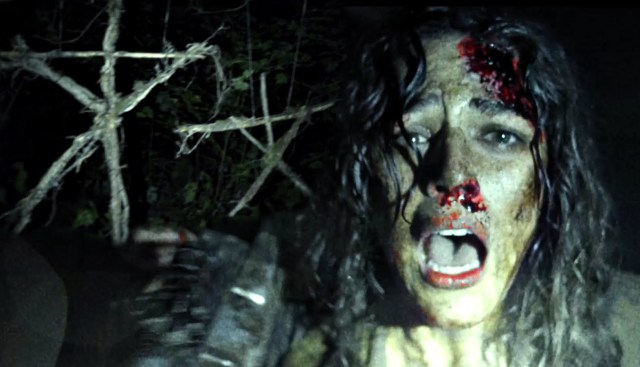We’re thrilled to welcome filmmaker George Popov back to Fright Club. His Sideworld docuseries explores different supernatural whatnot the world over, beginning with the Haunted Forests of England. So, we thought we’d comb through our favorite haunted forests together. Here’s what we came up with!
5. The Hallow (2015)
Visual showman Corin Hardy has a bit of trickery up his sleeve. His directorial debut The Hallow, for all its superficiality and its recycled horror tropes, offers a tightly wound bit of terror in the ancient Irish wood.
Adam (Joseph Mawle) and Clare Hitchens (Bojana Novakovic) move, infant Finn in tow, from London to the isolated woods of Ireland so Adam can study a tract of forest the government hopes to sell off to privatization. But the woods don’t take kindly to the encroachment and the interloper Hitchens will pay dearly.
Hardy has a real knack for visual storytelling. His inky forests are both suffocating and isolating, with a darkness that seeps into every space. He’s created an atmosphere of malevolence, but the film does not rely on atmosphere alone.
Though all the cliché elements are there – a young couple relocates to an isolated wood to be warned off by angry locals with tales of boogeymen – the curve balls Hardy throws will keep you unnerved and guessing.
4. Without Name (2016)
Haunting and hallucinatory, this Irish gem develops a menacing presence you cannot shake. Director Lorcan Finnegan (Vivarium) leads surveyor Eric (AlanMcKenna) into the Irish woods with no real hope of finding his way back.
Like The Hallow, this film braids ecological horror with the supernatural, all of it rooted in Irish folklore. The’s an understanding that not everything was pushed out once Catholicism took over, the two sides just kept their distance. But now that it’s big companies making the decisions, a lack of reverence in the presence of the past is more than one man can survive.
3. Antichrist (2009)
A meditation on grief and sexual politics, it’s not until Antichrist moves into its second act that you know the kind of film Lars von Trier has actually made. It’s a cabin in the woods horror show, and one of the very best.
Grief becomes something supernatural, a hellish nightmare perfectly suited to the type of woods Shakespeare wrote of. The forest is a lurking, magical place where danger and enchantment frolic.
In this case, they frolic perhaps too close to the tool shed.
2. The Blair Witch Project (1999)
Blair Witch may not date especially well, but it scared the hell out of a lot of people back in the day. This is the kind of forest adventure that I assume happens all the time: you go in, but no matter how you try to get out – follow a stream, use a map, follow the stars – you just keep crossing the same goddamn log.
One of several truly genius ideas behind Blair Witch is that filmmakers Daniel Myrick and Eduardo Sanchez made the audience believe that the film they were watching was nothing more than the unearthed footage left behind by three disappeared young people. Between that and the wise use of online marketing (then in its infancy) buoyed this minimalistic, naturalistic home movie about three bickering buddies who venture into the Maryland woods to document the urban legend of The Blair Witch. Twig dolls, late night noises, jumpy cameras, unknown actors and not much else blended into an honestly frightening flick that played upon primal fears.
1. The Witch (2015)
Ideas of gender inequality, sexual awakening, slavish devotion to dogma, and isolationism roil beneath the surface of the film, yet the tale itself is deceptively simple. One family, fresh off the boat from England in 1630 and expelled from their puritanical village, sets up house and farm in a clearing near a wood.
Every opportunity writer/director Roger Eggers has to make an obvious choice he discards, though not a single move feels inauthentic. Rather, every detail – whether lurid or mundane – feels peculiarly at home here. Even the most supernatural elements in the film feel appallingly true because of the reality of this world, much of which is owed to journals and documents of the time, from which Eggers pulled complete sections of dialog.
You are trapped as they are trapped in this inescapable mess, where man’s overanxious attempt to purge himself absolutely of his capacity for sin only opens him up to the true evil lurking, as it always is, in the woods.







